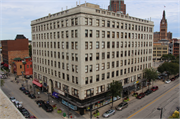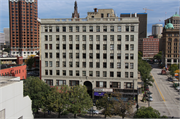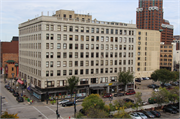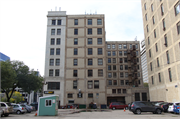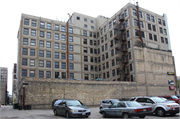Property Record
808 N Doctor Martin Luther King Jr Dr (AKA 808 N 3RD ST)
Architecture and History Inventory
| Historic Name: | Century Building |
|---|---|
| Other Name: | Century Building |
| Contributing: | |
| Reference Number: | 108660 |
| Location (Address): | 808 N Doctor Martin Luther King Jr Dr (AKA 808 N 3RD ST) |
|---|---|
| County: | Milwaukee |
| City: | Milwaukee |
| Township/Village: | |
| Unincorporated Community: | |
| Town: | |
| Range: | |
| Direction: | |
| Section: | |
| Quarter Section: | |
| Quarter/Quarter Section: |
| Year Built: | 1925 |
|---|---|
| Additions: | 1937 |
| Survey Date: | 200419842016 |
| Historic Use: | large office building |
| Architectural Style: | Neoclassical/Beaux Arts |
| Structural System: | |
| Wall Material: | Terra Cotta |
| Architect: | Alfred S. Alschuler |
| Other Buildings On Site: | |
| Demolished?: | No |
| Demolished Date: |
| National/State Register Listing Name: | Century Building |
|---|---|
| National Register Listing Date: | 8/28/2017 |
| State Register Listing Date: | 5/19/2017 |
| National Register Multiple Property Name: |
| Additional Information: | A 'site file' exists for this property. It contains additional information such as correspondence, newspaper clippings, or historical information. It is a public record and may be viewed in person at the Wisconsin Historical Society, State Historic Preservation Office. J.J. Quinn and Henry Schmitt were the builders. Classicized commercial block with terra cotta tile, moldings, and detail. Part of a body of work by the important Milwaukee architectural firm of Ferry and Clas. Last surveyed in 1984 with a map code of 148/8 on map 392. No updated card was provided in 2004-exterior remains the same. 2016- "This eight-story office building is known as the Century Building. As constructed in 1925, the first floor housed commercial space and the upper floors housed offices.16 The building has an L-plan main block with a one-story service wing in the ell. The structural system consists of reinforced-concrete columns and beams that are clad in a terra-cotta veneer on the primary facades (west and south) and brick infill on the north and east elevations. A mechanical penthouse extends from the roof of the main block. The primary facades consist of storefronts that feature plate-glass windows in metal frames, and the terra cotta veneer features Neoclassical ornamentation. The second floor mezzanine has Chicago windows, a central fixed window flanked by narrow double-hung sash. The mezzanine is separated from upper floors by a substantial belt course. Windows of the upper floors on the primary facade are one-over-one, double-hung sash. An ornate parapet projects above the roofline on both primary facades. The interior of the lobby retains many historic finishes, including marble walls and flooring, doors, fixtures, and three attendant-operated elevators." -"USH 18/Wells St: N 6th St to N Broadway", WisDOT#2200-14-00, Prepared by Mead & Hunt, Inc., (2016). 2016- "The Century Building is located at the northeast quadrant of the intersection of W. Wells Street and N. Third Street. The primary facades on both the west and south elevations of the building are separated from the street by a wide concrete sidewalk with ornamental lighting and concrete planters, and terrace trees are located along W. Wells Street. A parking lot is located to the north, and an alley on the east provides access to the building's service entrance and loading dock near the northeast corner. Designed by prominent Chicago architect Alfred S. Alschuler in a blend of the Neoclassical and Twentieth Century Commercial styles, the Century Building is an eight-story office building with commercial spaces at street level. Massing consists of an L-plan main block and a one-story service wing located in the ell junction at the northeast corner. A mechanical penthouse extends above the center of the roof of the main block. The building utilizes fireproof construction and the main block has a load-bearing framework of reinforced-concrete columns and beams. The primary (west and south) facades are clad in a terracotta veneer intended to mimic coursed dressed ashlar masonry, while the concrete skeleton is unadorned on the secondary (north and east) elevations. An ornate 2-foot-high parapet and balustrade projects above the roofline on both primary facades; elsewhere, a low brick parapet has a tile drip cap. Above the second story, windows on the primary facades are one-over-one, double-hung, metal sash, while those on the north and east elevations are a mixture of one-over-one and three-over-three, double-hung, metal sash with wired glass. The service wing has cream brick masonry walls and the flat roof has six pyramidal, wired-glass, box skylights. The west and south facades feature similar aesthetic treatment. Storefronts along N. Third and Wells Streets are accessible at street level and feature plate-glass windows in metal frames. On the second story or mezzanine level, fenestration consists of "Chicago windows" comprised of a central fixed pane flanked by narrower double-hung sash. The mezzanine window sills feature a Vitruvian wave motif. A substantial belt course separates the mezzanine story from the upper stories, with a fleur-de-lis motif beneath an ogee and Vitruvian wave, the latter of which serves as the sill for the third-story windows. The third through seventh stories are treated identically; the outermost two bays display ogee sills and Greek key headers, while the remaining units are separated vertically by recessed spandrel panels with central rosettes. A belt course serves as a running sill for the eighth-story windows, which are separated horizontally by recessed panels featuring garlanded urns. Swags adorn the frieze band above each window beneath a modillioned cornice. A balustrade surrounds the roof, alternating between sections of open balusters and solid sections with recessed round panels. On both primary facades, the balustrade features a central shield bearing the "CB" monogram surmounted by scrollwork. The west facade fronting N. Third Street features a central entry portal flanked by ornate lantern fixtures and angled flagpoles. A central shield adorns the belt course above a round-arch transom that illuminates the mezzanine level of the building. Bronze pilasters support a classically inspired bronze header, which features dentils and an egg-and-dart motif. Bas-relief dragons flank a central plaque bearing the inscription "Century Bldg." The adjacent storefront windows line both sides of the recessed entryway, which also features the bronze pilasters and cornice found on the entry portal. A set of four glazed bronze doors decorated with an acanthus motif provide access to the vestibule and lobby. Two storefronts with modern cloth awnings are located on the north side of the main entrance, and another is located on the south side. The southwest corner of the first story features a recessed angled entrance to the corner storefront. The storefront is clad in polished black granite veneer and features a Moderne-inspired curved chrome canopy that wraps around the corner of the facade. The south facade fronting W. Wells Street also has a central entrance, which is sheltered by a flat canopy with chrome trim. The recessed hallway has fluorescent overhead fixtures and a wide transom spans a set of paired doors flanked by single doors on each side, opening into a vestibule. The black granite facing of the corner storefront is echoed on either side of the entryway, while the remainder of the facade features ribbed aluminum paneling between the storefront windows and the mezzanine windows above. Storefronts east of the entrance feature metal surrounds with c.1960 angled windows and recessed doorways. The north and east elevations were historically obscured from the street by adjacent buildings and are unadorned, exposing the structural system of the building as a regular grid. Openings between the reinforced-concrete columns and beams contain regularly spaced windows in single and paired configurations, surrounded by cream brick infill. The one-story service wing contains a recessed loading dock on the east elevation. A metal fire escape is attached to the exterior near the northwest corner of the east elevation. Interior Each of the vestibules from the Wells and N. Third Street entrances opens onto an L-plan lobby via a set of four glazed bronze doors adorned with an acanthus motif on the handles and headers. The lobby features marble floors and walls and gilded rosettes adorn the coffered plaster ceiling. Doorways have marble surrounds with dentilled cornices, and the original brass postal box and directory board also feature profiled marble frames. A bank of three manually operated Otis elevators is located along the east wall of the lobby. A barber shop is located at the north side of the lobby, and a fireproof metal door to the north of the elevator bank opens onto a hallway to the service wing and basement stairs. Glazed wood doors serve as a secondary entrances to several of the storefronts as well. The marble wall and floor details are continued on the main stairway to the mezzanine level. Open plaster arches line the mezzanine, and decorative bronze railings in each archway echo the metal balustrade on the stairway. The mezzanine level features marble floors, walls, and door surrounds similar to those found in the lobby, and each of the three elevators has bronze sliding doors with frosted wired glass panes. Portions of the mezzanine hallways have drop ceilings with acoustical tiles and fluorescent fixtures, but office spaces that line the hallway retain their wood doors and frosted glass interior windows. The third through eighth floors were not accessible at the time of field survey; plans and permits indicate that these floors retain a general layout with an L-plan hallway lined by offices." -"Century Bldg", WisDOT# 2200-14-00, Prepared by Mead & Hunt, Inc., (2016). 2016: Designed by Alfred S. Alschuler, this eight-story office building is known as the Century Building. As constructed in 1925, the first floor housed commercial space and the upper floors housed offices. The building has an L-plan main block with a one-story service wing in the ell. The structural system consists of reinforced-concrete columns and beams that are clad in a terra-cotta veneer on the primary facades (west and south) and brick infill on the north and east elevations. A mechanical penthouse extends from the roof of the main block. The primary facades consist of storefronts that feature plate-glass windows in metal frames, and the terra cotta veneer features Neoclassical ornamentation. The second floor mezzanine has Chicago windows, a central fixed window flanked by narrow double-hung sash. The mezzanine is separated from upper floors by a substantial belt course. Windows of the upper floors on the primary facade are one-over-one, double-hung sash. An ornate parapet projects above the roofline on both primary facades. The interior of the lobby retains many historic finishes, including marble walls and flooring, doors, fixtures, and three attendant-operated elevators. |
|---|---|
| Bibliographic References: | Permit. Facade. 2016: Alschuler, Alfred S. “Building for Mr. Charles Kasik, N.E. Cor. Third & Wells Sts., Milwaukee, Wis.,” December, 1924. Available at City of Milwaukee, Department of City Records. Alschuler, Alfred S. “Alteration to Century Building, N.E. Cor. Third & Wells Sts., Milwaukee, Wis.,” November 16, 1936. Available at City of Milwaukee, Department of City Records. “Untitled.” Iron Trade 75 (December 11, 1924): 1546. |
| Wisconsin Architecture and History Inventory, State Historic Preservation Office, Wisconsin Historical Society, Madison, Wisconsin |

